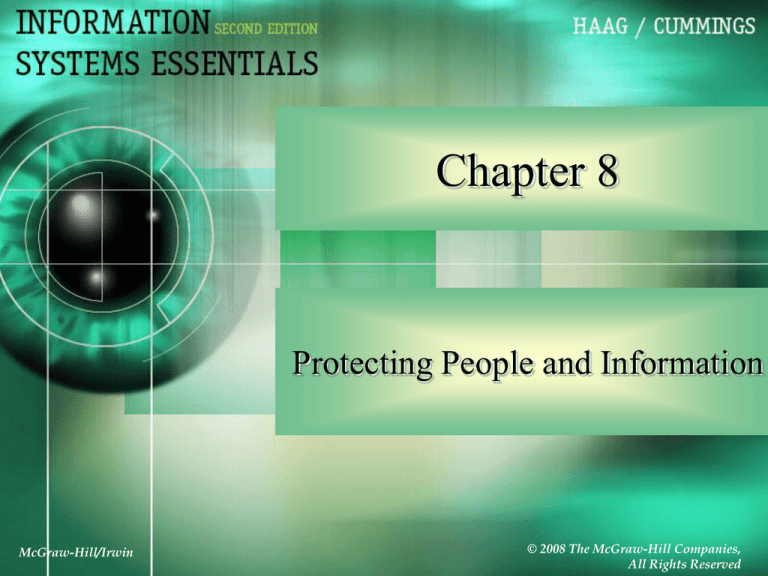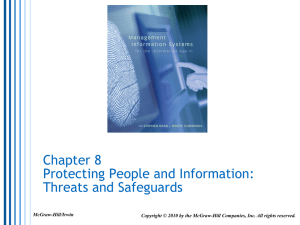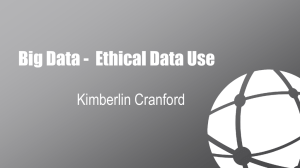
Chapter 8
Protecting People and Information
McGraw-Hill/Irwin
© 2008 The McGraw-Hill Companies,
All Rights Reserved
STUDENT LEARNING OUTCOMES
4. Describe the ways in which information on
your computer or network is vulnerable.
5. Define risk management and risk assessment
and describe the seven security measures that
companies can take to protect their
information.
8-2
They Know about 96 Percent of
American Households
• The Acxiom company, in Little Rock, handles
consumer information for marketing purposes
• Acxiom gets information from the three major
credit bureaus
8-3
They Know about 96 Percent of
American Households
• Customers: 9 of the 10 largest credit-card
issuers
• Acxiom has 20 billion records on
– 110 million people
– 96% of households
• Makes and sells lists to customers
• Merges and protects databases
8-4
They Know about 96 Percent of
American Households
• Class poll
1. Is the privacy of consumers threatened by
companies such as Acxiom?
2. What are the advantages to consumers of
companies selling information on them?
3. What are the disadvantages?
8-5
INTRODUCTION
• Handling information responsibly means
understanding the following issues
–
–
–
–
Ethics
Personal privacy
Threats against information
Protection of information
8-6
ETHICS
• Ethics – the principles and standards that
guide our behavior toward other people
• Ethics are rooted in history, culture, and
religion
8-7
Factors that Determine How You
Decide Ethical Issues
• Actions in ethical dilemmas determined by
– Your basic ethical structure
– The circumstances of the situation
• Your basic ethical structure determines what
you consider to be
– Minor ethical violations
– Serious ethical violations
– Very serious ethical violations
8-8
Basic Ethical Structure
8-9
Circumstances of the Situation
•
•
•
•
•
Consequences of the action or inaction
Society’s opinion of the action or inaction
Likelihood of effect of action or inaction
Time to consequences of action or inaction
Relatedness of people who will be affected by
action or inaction
• Reach of action or inaction
8-10
Guidelines for Ethical Computer
System Use
• Talk to someone whose judgment you trust
• Visit company’s ethical ombudsman
• Ask lots of questions about what you’re being
asked to do (couch questions in terms of
company’s best interest)
• You may have to refuse to do something you
consider unethical
8-11
Intellectual Property
• Intellectual property – intangible creative
work that is embodied in physical form
• Copyright – legal protection afforded an
expression of an idea
• Fair Use Doctrine – may use copyrighted
material in certain situations
8-12
Intellectual Property
• Using copyrighted software without
permission violates copyright law
• Pirated software – the unauthorized use,
duplication, distribution, or sale of copyrighted
software
8-13
PRIVACY
• Privacy – the right to left alone when you want
to be, to have control over your own personal
possessions, and not to be observed without
your consent
• Dimensions of privacy
– Psychological: to have a sense of control
– Legal: to be able to protect yourself
8-14
Privacy and Other Individuals
• Key logger (key trapper) software – a program
that, when installed on a computer, records
every keystroke and mouse click
• Screen capture programs – capture screen from
video card
• E-mail is stored on many computers as it
travels from sender to recipient
• Hardware key logger – hardware device that
captures keystrokes moving between keyboard
and motherboard
8-15
An E-Mail Is Stored on Many
Computers
8-16
Online Social Networks
• Be careful concernin what information you
place on these
• Popular – MySpace, FaceBook, Xanga, Bibo
• Estimated that 1 in 5 social network
participants will receive some kind of sexual
offer
• Again, be careful… very careful
8-17
Identity Theft
• Identity theft – the forging of someone’s
identity for the purpose of fraud
8-18
Identity Theft
• Phishing (carding, brand spoofing) – a
technique to gain personal information for the
purpose of identity theft
• NEVER
– Reply without question to an e-mail asking for
personal information
• Click directly on a Web site provided in such
an e-mail
8-19
Identity Theft
• Facts on phishing…
– February 2005 – 2,625 phishing sites
– Consumers lost $500 million to phishers in 2004
– 70% people report visiting a fake site
• What to do if you suspect you’re at risk
– Close your credit card accounts (use ID theft
affidavit form)
– Place a fraud alert on your credit reports
– Ask government to flag your files
8-20
Privacy and Employees
• Companies need information about their
employees to run their business effectively
• As of March 2005, 60% of employers
monitored employee e-mails
• 70% of Web traffic occurs during work hours
• 78% of employers reported abuse
• 60% employees admitted abuse
8-21
Privacy and Employees
• Cyberslacking – misuse of company resources
• Visiting inappropriate sites
• Gaming, chatting, stock trading, etc.
8-22
Monitoring Technology
• Example of cost of misuse
– Watching an online fashion show uses as much
bandwidth as downloading the entire Encyclopedia
Britannica
• Reasons for monitoring
– Hire the best people possible
– Ensure appropriate behavior on the job
– Avoid litigation for employee misconduct
8-23
Privacy and Consumers
• Consumers want businesses to know who they
are, but not to know too much
• Provide what they want, but not gather
information on them
• Let them know about products, but not pester
them with advertising
8-24
Cookies
• Cookie – a small file that contains information
about you and your Web activities, which a
Web site places on your computer
• Handle cookies by using
– Web browser cookie management option
– Buy a program that manages cookies
8-25
Spam
• Spam – unsolicited e-mail from businesses
advertising goods and services
• Gets past spam filters by
– Inserting characters
– Inserting HTML tags that do nothing
– Replying usually increases, rather than decreases,
amount of spam
8-26
Adware and Spyware
• Adware – software to generate ads that installs
itself when you download another program
• Spyware (sneakware, stealthware) – software
that comes hidden in downloaded software and
helps itself to your computer resources
8-27
Adware in Free Version of Eudora
8-28
Trojan Horse Software
• Trojan horse software – software you don’t
want inside software you do want
• Some ways to detect Trojan horse software
–
–
–
–
AdAware at www.lavasoftUSA.com
The Cleaner at www.moosoft.com
Trojan First Aid Kit (TFAK) at www.wilders.org
Check it out before you download at
www.spychecker.com
8-29
Web Logs
• Web log – one line of information for every
visitor to a Web site
• Anonymous Web browsing (AWB) – hides
your identity from the Web sites you visit
– The Anonymizer at www.anonymizer.com
– SuftSecret at www.surfsecret.com
8-30
Privacy and Government Agencies
• About 2,000 government agencies have
databases with information on people
• Government agencies need information to
operate effectively
• Whenever you are in contact with government
agency, you leave behind information about
yourself
8-31
Government Agencies Storing Personal
Information
• Law enforcement
– NCIC (National Crime Information Center)
– FBI
• Electronic Surveillance
–
–
–
–
Carnivore or DCS-1000
Magic Lantern (software key logger)
NSA (National Security Agency)
Echelon collect electronic information by satellite
8-32
Government Agencies Storing Personal
Information
•
•
•
•
•
•
•
IRS
Census Bureau
Student loan services
FICA
Social Security Administration
Social service agencies
Department of Motor Vehicles
8-33
Laws on Privacy
• Health Insurance Portability and
Accountability Act (HIPAA) protects personal
health information
• Financial Services Modernization Act requires
that financial institutions protect personal
customer information
• Other laws in Figure 8.7 on page 281
8-34
SECURITY
• Attacks on information and computer
resources come from inside and outside the
company
• Computer sabotage costs about $10 billion per
year
• In general, employee misconduct is more
costly than assaults from outside
8-35
Security and Employees
• Statistics on white-collar crime
–
–
–
–
–
Costs an estimated $400 billion annually
Average nonmanagerial embezzlement is $60,000
Average managerial embezzlement is $250,000
Two-thirds of insider fraud is not reported
Of known losses, one-quarter cost more than $1
million
8-36
Types of Cyber Crime
• Computer virus (virus) – software that is
written with malicious intent to cause
annoyance or damage
• Worm – type of virus that spreads itself from
computer to computer usually via e-mail
• Denial-of-service (DoS) attack – floods a Web
site with so many requests for service that it
slows down or crashes
8-37
Computer Viruses Can’t…
• Hurt your hardware
– Ex: Monitors, printers, processors, etc.
• Hurt any files they weren’t designed to attack
– Ex: A worm designed to attack Outlook won’t
attack other e-mail programs
• Infect files on write-protected media
8-38
Risk Management & Assessment
• Risk management –
– The identification of risks or threats
– The implementation of security measures
– Monitoring of measures for effectiveness
• Risk assessment – asks
– What can go wrong?
– How likely is it to go wrong?
– What will the consequences be?
8-39
Security Precautions
1. Backup – process of making a copy of
information
2. Anti-virus software – detects and removes or
quarantines computer viruses
3. Firewall – hardware and/or software that
protects a computer or network from intruders
8-40
Security Precautions
4. Access Authentication
– Biometrics – the use of physiological
characteristics for identification purposes
5. Encryption – scrambles the contents of a file
so that you can’t read it without the
decryption key
– Public Key Encryption (PKE) – an encryption
system with two keys: a public for everyone and a
private one for the recipient
8-41
Security Precautions
6. Intrusion detection software – looks for
people on the network who shouldn’t be there
or who are acting suspiciously
7. Security-auditing software – checks out your
computer or network for potential weaknesses
8-42
CAN YOU…
1. Define ethics and describe the two factors that
affect how you make a decision concerning an
ethical issue.
2. Define and describe intellectual property,
copyright, Fair Use Doctrine, and pirated
software.
3. Define privacy and describe the ways in
which it can be threatened.
8-43
CAN YOU…
4. Describe the ways in which information on
your computer or network is vulnerable.
5. Define risk management and risk assessment
and describe the seven security measures that
companies can take to protect their
information.
8-44




